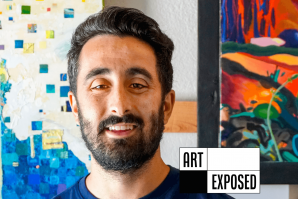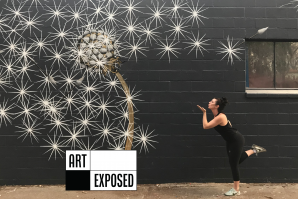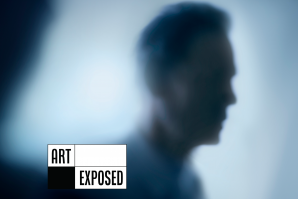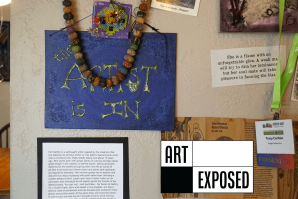Rural artist Katharine T. Jacobs is known to spend her days in coveralls, hands and clothes speckled with clay and stains from botanical pigments. As a single mom to her daughter, 7-year-old Paloma, Jacobs wears both mom and artist hats while working in her Pine Grove garage-turned-studio. Sometimes, she takes to the outdoors — including her backyard — creating haunting and evocative nude portraits on black-and-white film.
Jacobs, a 37-year-old interdisciplinary artist from Amador County, recently earned an MFA in spatial art from San Jose State University. Before attending graduate school, Jacobs, who grew up among the hills, trees and quaint historic towns of nearby Calaveras County, studied at California College of the Arts in Berkeley and earned a BFA in photography at Oregon College of Art and Craft.
Jacobs returned to the area from Portland in 2018, leaving behind an abusive marriage, armed with an infant and a new diagnosis of multiple sclerosis. This inflammatory disease of the central nervous system is incurable and typically gets worse over time, creating problems with vision, balance and memory while causing muscle weakness, numbness and pain. For Jacobs, it started with numbness in both feet, then a feeling of “pins and needles” on the entire left side of her body and a feeling of wetness when wearing clothes. Today, she still has the feeling of numbness and tingling in her forearms and hands, torso and legs and chronic fatigue.
“Pleasure Circuit” is a body of work featuring ceramic casts of
the artist’s body, addressing the medical gaze, body dysmorphia
and the effects of trauma. (Photo by Susan Harding)

A recent exhibition, “Playthings,” at Yorba Gallery in Sutter Creek, displayed Jacob’s uncanny ability to transform materials — in this case, cast porcelain dolls, some with hand-sewn bodies — into striking metaphors for her own experience.
In her artist’s statement, Jacobs explains her choice of the doll as a sculptural form: “Through research of the psychological correlation between trauma and illness as well as the historical practice of doll making intended to transfer pain and manifest healing in many cultures I was inspired to create these vessels for my own healing process. … I was able to compartmentalize my experiences that had previously overwhelmed me into tidy, healing, mixed media vessels.”
“Pleasure Circuit” has been exhibited in various galleries
including Pamela Walsh Gallery in Palo Alto, Volcano West Gallery
in Volcano and Walters Cultural Art Center in Oregon. (Photo by
Susan Harding)

“Pleasure Circuit,” a body of work that includes distorted porcelain casts Jacobs created of her own form, confronts the experience of being a disabled woman, connecting trauma and abuse with physical illness, while also speaking to the strength and resilience of the human body.
The forms have been distorted and glazed with hints of yellow and purple, emphasizing Jacob’s own body dysmorphia. The backsides of the forms also feature stream-of-consciousness drawings that Jacobs says include “a lot of dreams, a lot of phrases, a lot of just the visuals that pop into my head while I’m painting and not being like, ‘This has to mean this or it’s not art.’”
The reverse side of Jacobs’ body casts feature
stream-of-consciousness drawings and colorful underglaze. (Photo
courtesy of Katharine T. Jacobs)

Jacobs also creates botanical works using the historic cyanotype process, going back to her roots as a fine art photographer. She often includes cyanotype imagery in her 3D work as well, whether printed directly on the body of a doll or on crumpled prints at the foot of her sculptures.
Jacobs uses multiple mediums to create her immersive mixed media
works including fabric and ceramics. (Photo by Kelly Curtis)

I’ve always said I was a conceptual fine artist, but now a conceptual mixed media artist, but really clinging to that fine art title. I think that encompasses a lot. And I used that back when I was a photographer, and I’ve always leaned on that word conceptual.
Your work integrates sculpture, photography and textiles. How do you decide which medium or combination of mediums is best suited for a particular concept or idea?
I really just let the material speak to me. And if I need a solution, like, oh, I made this head out of ceramics, but I’m not going to make a full ceramic body. I can make a fabric body. And I do lean into a lot of those other nontraditional methods of making.
Jacobs and daughter, Paloma, making a cyanotype in her garage
studio. (Photo by Kelly Curtis)

I really love and hate the concept of women’s work, but I think my work feels innately feminine no matter what I’m doing, and I really try to embrace that as a positive. And I also, I love the strange and the macabre, but I also really love beauty. So I’m always grappling with that space.
In “Playthings,” Jacobs uses handmade porcelain dolls “to
compartmentalize my experiences that had previously overwhelmed
me into tidy, healing, mixed media vessels.” (Photo courtesy of
Katharine T. Jacobs)

Yeah, I see myself as a disabled artist. If you saw me on the street, you probably wouldn’t know that. But that’s not my job to explain an invisible illness to anybody. So yeah, a lot of the grants and the way that I write about my work is, I mean, I’m obviously a feminist, but disabled, and I’m a real advocate for trauma survivors and addiction. I spent a lot of time going to Al-Anon and Nar-Anon meetings and doing all that. So I think that that is all encompassed in my work. But for my elevator speech, it’s like, yeah, I’m a disabled intersectional feminist.
Your work focuses heavily on the body, without sexualizing, objectifying or focusing specifically on beauty like so much of art does. Is this intentional, and if so why is that an important part of your work?
I think my photographs are more beautiful, but they always have this of — there’s a slight jarring-ness to them. And with the body cast, those I intentionally manipulated. … It started really as me trying to talk about losing trust in my body and the medical gaze. People talk about the male gaze, but the medical gaze is the way you feel as a patient being inspected and evaluated. And so I was really trying to convey that, objectifying my own body, but in a non-sexual way as almost a medical way, like a slab of meat.
Jacobs often incorporates botanical cyanotype photography into
her works, such as this fabric doll body. (Photo courtesy of
Katharine T. Jacobs)

I’ve seen people have a lot of fun looking at the stuff on the back. So even one of the second times (Pleasure Circuit) was installed, it was at our MFA show in Santa Cruz, and it was a family friend of one of the other guys who lives in Fresno, and they’re all farmer guys, so it was just not your typical art guy. He was there to support the family, and he was just loving it — he brought his wife over and was like, “Look at all this.” And they were like, “What’s with all the horses, or what’s with all the penises?”
And then that led me to be able to be like, well, it’s like a self-portrait, and it’s kind of about living with a chronic illness and losing faith in your body, but it’s also about everything that’s led to it. I mean a huge, it’s a lot to do with addiction. My dad was an addict, and my ex-husband was an addict. And so my relationship to addicts and kind of the chaos that is involved in that. And so I was able to just have that conversation with someone who — and they left being like, “Wow, okay. It’s about a lot.”
Exhibiting this work that’s so personal and vulnerable — what has that experience been like for you? Have you had reservations about it, or are you just excited to show it every time?
Yeah, I think that’s where I’m like, I know I’m an artist. I can’t do anything but that and in a lot of ways it feels better than putting other nudes of other people on display. When I’ve had photography shows where that’s the work, for this, at least I know that I’m the one at risk. So I’ve only had positive experiences, but I can’t help but be that way I think. So I don’t really have a choice. I feel that way a lot in art making. I’m like, I literally can’t help it. I have to do it. And I’m really lucky I’ve been able to come live with family and have a safe place to go and have that be part of my life, and that’s what’s kept me really healthy.
Edited for length and clarity.
Stay up to date on art and culture in the Capital Region: Follow @comstocksmag on Instagram!
Recommended For You

Art Exposed: Taner Pasamehmetoglu
For this second-generation American, art is a tool to address finite resources and break down walls
“A lot of my work stems from this idea of what I call being stuck in between,” says multidisciplinary Elk Grove artist Taner Pasamehmetoglu.

Art Exposed: Maren Conrad
Meet the Sacramento muralist and designer who creates joyful spaces for women
Maren Conrad reflects on her iconic Sacramento murals and her latest project, the Jacquelyn.

Art Exposed: Doug Winter
Elk Grove photographer creates images exploring perception and memory through the lens of visual impairment
After suffering a stroke in his right eye in 2012, Elk Grove resident Doug Winter, a trained commercial photographer, began to think differently about sight and perception.

Art Exposed: Tracy ‘Indi’ Carlton
Meet the Amador County artist who traded in a 21-year nonprofit career to become a creative expression coach
Tracy Carlton took an unconventional path to her art career, launching a as a creative expression coach and teacher last year following a 21-year career at First 5 Amador, the Amador County branch of the statewide nonprofit commission dedicated to improving early childhood development.



